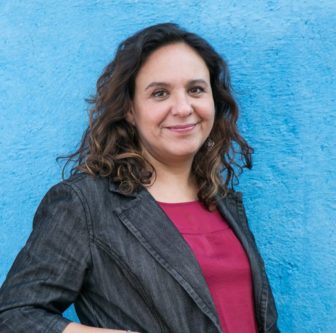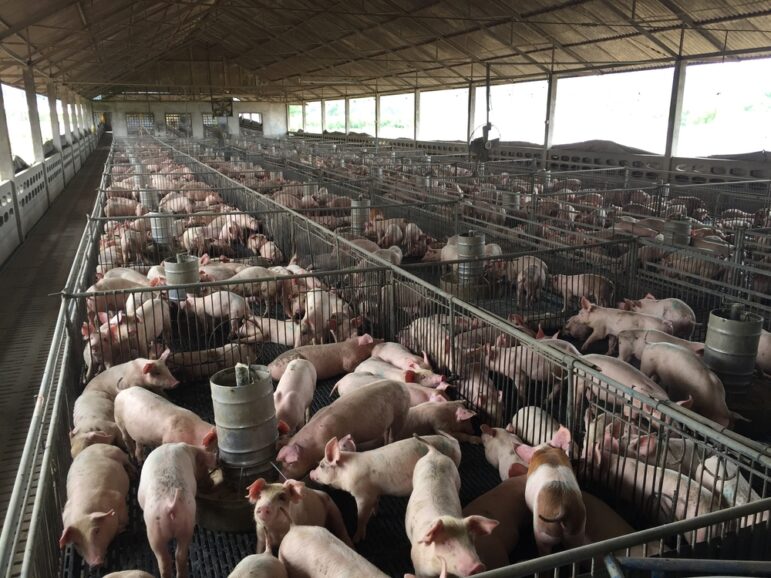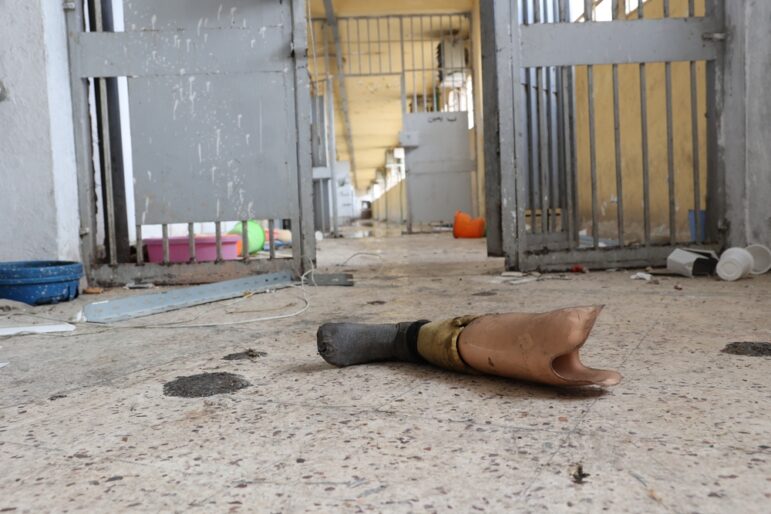

Political Kidnapping and Forced Disappearances

A protester marches in Mexico City to claim justice in the case of 43 students who were disappeared in Ayotzinapa. Her t-shirt says: “Their pain is our pain.” Image: Shutterstock
Editor’s Note: For the next few weeks, GIJN is running a series drawn from our forthcoming Reporter’s Guide to Investigating Organized Crime, which will debut in full in November at the Global Investigative Journalism Conference. This section, which focuses on forced disappearances, is written by Marcela Turati, an investigative journalist who has covered the Mexican drug war and who is a founding member of the reporting project Quinto Elemento Lab.
In one of the first episodes of the TV series “Breaking Bad,” two of the main characters dissolve a corpse in a bathtub filled with acid. This disturbing scene depicts the obstacles these crystal meth producers must overcome to get rid of a body, but ultimately, the experiment is so successful they repeat it in later episodes.
While on Netflix this gruesome detail is used for dramatic effect, these characters are using a tool that been used by security forces and organized crime gangs, a crime that violates several human rights, but which has nonetheless spread as a practice around the world: the disappearance of people.
At first, forced disappearances were used in wars as a technique to prevent corpses of enemies from being returned to their homeland, by authoritarian regimes as a brutal, counterinsurgency tactic (as seen throughout Latin America in the 1970s), or to install terror among the people considered enemies in a civil war (with the most well-known examples of this taking place in Spain, Bosnia and Herzegovina, Rwanda, Syria, and Iraq). This practice has been refined by organized crime groups.
The investigation of a disappearance begins when a person goes missing or when an unidentified body is discovered.
Disappearing people benefits the perpetrators in several ways: it considerably complicates any investigation, the victims — dead or alive — remain hidden most of the time, and it can be mixed or confused with other crimes, such as kidnapping, child abduction, human trafficking, forced recruitment, or murder.
As demonstrated in countries like Mexico and Guatemala, the same agents who have applied illicit counterinsurgency or state terrorism methods have later trained criminal organizations in the torture, murder, or disappearing of people.
There is also evidence that in countries with high levels of impunity and corruption, the perpetrators are protected and state agents are complicit in these disappearances, if these agents do not commit the crimes themselves. Narcotics, and dirty money, also complicates the situation. “The rise of the illegal narcotics industry in South and Central America has produced a toxic combination of drug cartels, right-wing and left-wing paramilitaries and heavy-handed security forces,” a recent International Commission on Missions Persons (ICMP) report concluded. “In every instance, this has resulted in an epidemic of intimidation, murder, and disappearance.”
According to the United Nations, hundreds of thousands of people have vanished during conflicts or periods of repression in at least 85 countries around the world. But because many countries do not report statistics on this crime and because there is no globally accepted definition of it, it is impossible to accurately estimate how many people are disappeared each year. For example, some countries only count victims of enforced disappearance committed by government agents, others tally any disappearance related to violence, and others include all people whose whereabouts are unknown for any reason, such as war, migration, or natural disasters.
As well as the devastating personal and emotional impact for the family members of those who are disappeared, there are economic implications too. An Australian study estimates that each missing person costs its community the equivalent of $1,770 USD — a figure that includes search costs, loss of earnings while family members look, and health and legal costs.
The methods of disappearing people vary widely, and depend on certain contexts. In places like Venezuela or India, people who work in illicit mining are known to have disappeared; in the Philippines, it happens to people whom the government considers delinquents or drug dealers; in Mexico, it could be people caught in territorial disputes of criminal groups; Vietnamese children can go missing inside Europe-bound smuggling networks; some fishermen forced into slave labor in the Thai seafood industry are never seen again; and the Italian mafia has dissolved some victims in acid.
Criminals disappear people for different reasons: to punish perceived enemies, harm people who could hinder business, terrorize communities (thus controlling people and territories), and send a message regarding the ownership of a place, trade route, or market. It is also used to conceal murders by removing the corpus delicti (body of a victim — and evidence of a crime), thereby avoiding unwanted attention from the police.
Forced disappearance is a crime that never ends: it continues until the victim reappears, dead or alive. The uncertainty of not knowing the whereabouts of the victim has a destructive force, and amounts to constant torture for those who seek this person. This uncertainty can rob them of their health, savings, social ties, stability, life plans, and emotional and psychological well-being. Besides the family, a disappearance affects other people the victim was close to, and ripples out to the entire community. On top of all this, impunity adds a constant source of revictimization.
No single investigative journalism method can be applied to these crimes, because every criminal group operates according to its own rules, capabilities, and context — and where state agencies are complicit or directly involved, the full picture can be even harder to ascertain.
There is evidence that different organizations have people who specialize in making others disappear. This could mean subjecting their victims to forced labor camps, murdering them and hiding the bodies underground or underwater, dissolving them in acid, or cremating them. There are no limits to what cruelties can be imagined.
It is rare to find a victim through reporting. Journalists can mostly help in reconstructing the context of the disappearance, showing the criminal pattern of the perpetrating group, investigating who the victims and the perpetrators are, going into how state agents were involved, assessing the successes — or failures — of official investigations, and possibly clearing up confusing events, such as the place, motive, and kind of disappearance.
Journalists must use varied methods to get the information, given that the press does not have the reach of a prosecutor’s office, which has the power to interview perpetrators, go into security centers where people are retained, dig up possible burial sites to search for remains, and conduct genetic analysis of human remains to identify the murdered person.
Sources
Begin the investigation by collecting the largest amount of news publications, articles, images, and sources that can provide better context regarding the case. While going through the material, identify angles, other sources, and personal risks involved in the investigation, which is very important.
The following organizations have recognized experts on disappearances:
- The International Commission on Missing People (ICMP) specializes in looking at missing persons cases and is well versed in international legislation on the issue.
- The Missing Migrants Project of the International Organization for Migration (IOM) tracks incidents involving migrants, including refugees and asylum-seekers, who have died or gone missing in the process of migration.
- The Office of the United Nations High Commissioner for Human Rights (OHCHR) addresses human rights issues relating to migrants and victims of crime. It has a Committee on Enforced Disappearances.
- Amnesty International also looks at cases of enforced disappearances.
- Human Rights Data Analysis Group (HRDAG) was a collaborator on finding mass graves in Mexico. They have used data to look at enforced disappearances and published reports on specific countries.
- Equipo Argentino de Antropología Forense (EAAF). This Argentinian group applies forensic science techniques when searching, recovering, and identifying missing people.
- The International Committee of the Red Cross (ICRC) looks at disappearances around the world.
Before conducting fieldwork, it’s essential to know as much as possible about the criminal groups that operate in the region as well as the background of local law enforcement, to detect likely patterns of protection.
Be skeptical of other media reports, because journalists could be censored. Instead, look for sources that are knowledgeable of the criminal dynamics, draw a map of the related stakeholders, determine in which order and in what moment they will be contacted, and always calculate the security risks to any investigation.
Always seek to have contacts in the area before traveling to your reporting site, a personal safety protocol in case of emergency, and avoid carrying information that could compromise the investigation or other sources.
Make a plan focused on trying to establish who disappeared a given person or group, and how. Also, ascertain if the victim could be alive, dead, or detained, if there are any clandestine graves or unidentified bodies, and if this fits a pattern for the area.
- Family members and people close to the victim
The approach and the interviews must be conducted with a great deal of respect, empathy, and tact. In most cases, family members have investigated and have information on the case. It’s important to consult with experts on how to conduct these interviews without re-traumatizing the victim’s family or friends.
Journalists must carefully consider how painful events can impact what people remember. Memories may be distorted by the passage of time, news, opinions of other people, and by forgetting certain details. In all cases, it is important to look for evidence that supports these testimonies, and avoid forcing a version of reality by omitting contradictory versions.
- Witnesses
While conducting fieldwork, find out who could have witnessed the disappearance and ask about details.
- Survivors
The most valuable information could come from people who were captive with the victim. Fear could keep them from talking, so in all interviews, journalists must prioritize the safety of sources and avoid revictimization. In many cases, people who have been forcefully displaced or have left the country where they were targeted find it easier to talk.
- Human rights advocates, lawyers, collectives, community leaders, clergy
Families who have organized into a group, where there are similarities in their cases, could have information that proves useful in noticing patterns related to the crimes they’ve been trying to solve.
- Judicial documents
Are there imprisoned people who could have first-hand information about the criminal networks investigated? Has someone testified against the criminal group? Remember that all information must be cross-checked with other sources.
- Freedom of Information requests
Often the information reporters want is not public, but it exists. To obtain it, they must use transparency tools such as FOI laws or institutions inside their own countries — or other countries — related to the cases.
- Other open sources
Look for information on social media accounts belonging to the disappeared person. Search for clues in their activities, contacts, and other public tools. It’s useful to organize the information in Excel spreadsheets.
- Police and prosecutors
These are the people responsible for the official investigation. Be careful not to publish any details that could jeopardize their investigation, tip off or inadvertently assist the perpetrators, or further endanger the victims.
When consulting with police or law enforcement, avoid revealing any key information you have on the crime or any suspicions you may have that the authorities may be colluding with the criminals.
- Independent forensic experts
They help determine if any documents obtained are true, and provide views on specialized matters, such as the reliability of the government’s procedure in obtaining genetic evidence.
Case Studies
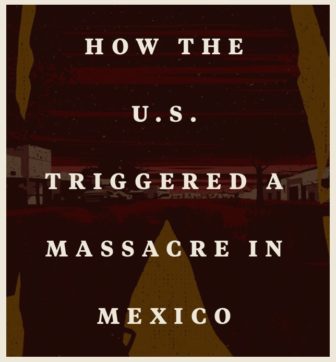
ProPublica’s exposé on how US drug enforcement agents triggered a massacre in Mexico. Image: Screenshot
How the US Triggered a Massacre in Mexico
This 2017 ProPublica project tells the story of a drug-related massacre in Allende, Mexico, and the dozens of people deemed missing as a result. During several trips to the area to generate trust, the authors spoke to victims and witnesses, and collected 911 calls and other official documents. The reporting was conducted in Mexico and the United States to reconstruct what happened, how many people went missing, and their stories.
Slave Work in the Fishing Industry
An NGO took AP journalists to a remote Indonesian island with 2,000 enslaved workers, whose families no longer knew their whereabouts. The reporters interviewed and followed the people who returned home, and documented clandestine graves, where the dead had been buried under false names. The investigation, which won the 2016 Pulitzer Prize, prompted the Indonesian authorities to rescue the enslaved workers and detain some of the captors.
Gone: Inside Families’ Risky Search to Uncover the Truth
This 2020 Globe and Mail investigation narrated how nine Mexican families found loved ones in a clandestine grave on the outskirts of the Mexican port city of Veracruz. The newspaper’s digital team created a 3D model of the grave, and combined it with terrain images, and testimonies of volunteers who excavated it. This helped to illustrate the scale of the area.
Tips and Tools
Act Fast, but Take Precautions
It’s important to obtain information during the first few hours after a disappearance. The victim could have left important clues on social media or through text messages, there could be witnesses and camera recordings from neighboring houses or businesses, or pedestrians who managed to film something of interest. Remember, if you have access to security cameras, you have evidence. You are not the police, so you can copy the original recording with your phone, but you should not take the original with you.
Use Geolocation Technology
Once you have the permission and cooperation of families, you can try to ascertain if the victim used their telephone. Other geolocation tools could be available as well. Also, you can see if the victim received calls before or after the disappearance. Typically, the government can obtain this registry as part of the investigation, identify telecommunication antennas nearby, and establish a possible location radius. And in some countries, this information can be made available to families, and then, through them, journalists.
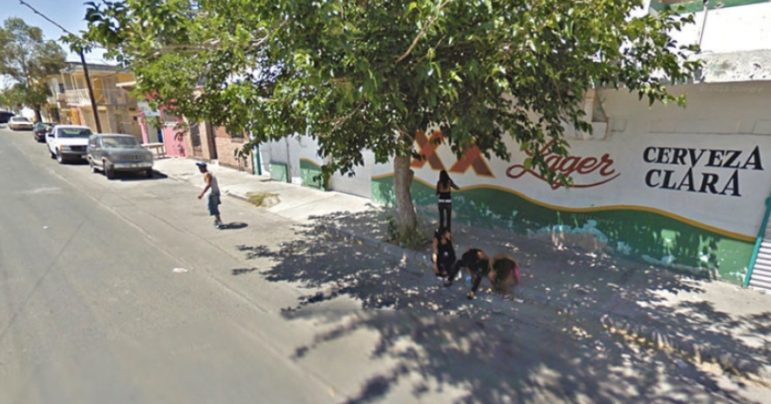
Several Mexican women who later went missing or were murdered were recognized sitting outside a hotel-bar in Juárez in a 2009 Google Street View image. Image: Screenshot (Google Street View)
Use Google Earth, Google Street View, and Satellite Images
These tools allow reporters to see areas that are difficult to access or are under criminal control. In Juárez, for example, a 2009 Google Street View image captured a group of young women who later disappeared standing outside a hotel where dozens more were subjected to sexual trafficking. Drones can be used as well, but you must evaluate the risk in places controlled by criminals.
Verify the Truthfulness of Documents and Statements
Even forensic or government information obtained through transparency platforms or interviews could be false. Be aware that official information you have access to could be manipulated, whenever there are conflicts of interest or corruption. Always look for experts who can help analyze and verify evidence and forensic information.
“Fish” for Information and Wait
In some cases, it could be worthwhile to publish some initial findings, to attract new sources and “fish” for more information. If it becomes known that an investigation is underway, some people might be motivated to speak up.
Proceed with Caution when Alleged Victims are Found
Don’t rush to conclusions when a disappeared person’s corpse has been found — even if clothing, tattoos, or personal documents match. Giving out this information without genetic confirmation, or the validation of experts, will harm the families and betray their trust in you.
Digital, Physical, and Emotional Security
You must establish clear protocols for physical, psychological, and digital security. Know how you should communicate with your sources and protect sensitive information.
Investigating disappearances can be distressing, frustrating, and dangerous. The cases could involve images of corpses and torture, and interviews with traumatized people. It’s important to have a support network that you trust, self-care routines, and in complex cases, to attend therapy.
Conclusion
Investigating disappearances is no minor challenge. Because of the generalized violence and impunity of perpetrators often involved, the duty of each journalist is to think of the potential consequences their publication or broadcast may have for the people interviewed and for the victims. Also, carefully evaluate what risks exist when sources speak to a journalist, ask if the sources are willing to take those risks, and how they may be reduced.
Your priorities are obtaining valuable information while ensuring victims are not revictimized by your work. Remember to always keep your sources, investigation, and yourself safe.
Additional Resources
How to Investigate Forced Disappearances in Latin America
GIJN on YouTube: How to Investigate Organized Crime and Missing People
Tracking Down the Disappeared: Top Tips from Investigative Reporters on the Front Lines
Marcela Turati is a freelance investigative journalist covering the Mexican drug war. She is the co-founder of the network Periodistas de a Pie (Journalists on Foot) and a founding member of the reporting project Quinto Elemento Lab. She is a 2017 Nieman Fellow, the recipient of the 2013 Louis M. Lyons Award for Conscience and Integrity in Journalism, and of the 2019 Maria Moors Cabot Prize.





